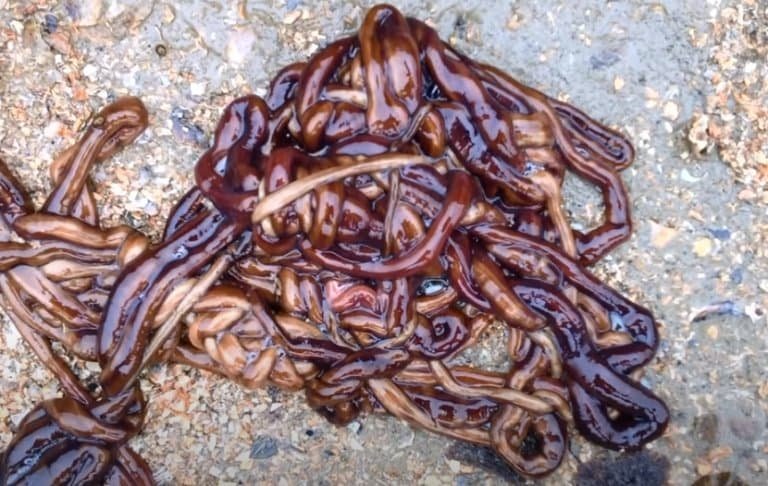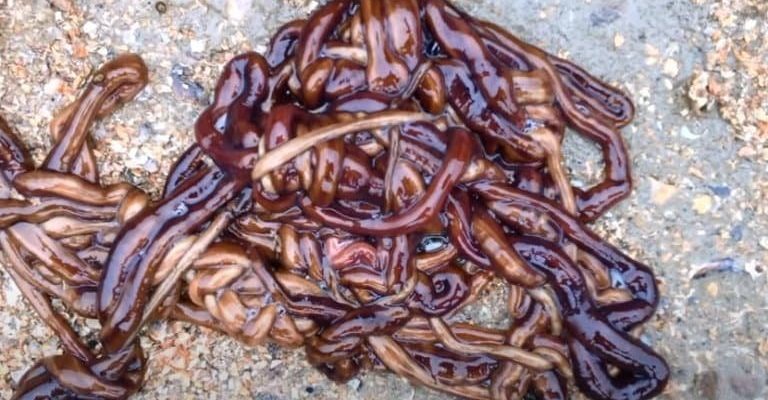
Let’s dive into the world of bootlace worms. Imagine walking along a serene beach in Northern Europe, feeling the cool breeze and hearing the gentle waves lapping at the shore. Suddenly, you spot a long, thin organism squirming in the shallows. What you’ve seen is likely a bootlace worm, stretching out like a piece of spaghetti, often hiding among seaweeds or sandy patches. In this guide, we’ll explore their anatomy, habitat, behavior, and the role they play in the ecosystem, turning you into a mini-expert on these extraordinary creatures.
What Are Bootlace Worms?
Bootlace worms belong to the marine phylum called Annelida, which means they are segmented worms. Instead of the typical worm’s cylindrical shape, bootlace worms can look like long ribbons or, as the name suggests, bootlaces. They can reach lengths of up to **30 meters**, depending on their environmental conditions. You might be wondering how such a long worm manages to fit into this world without being seen. The truth is, they often hide in habitats that provide cover, like sea grasses or under rocks, making them a bit elusive.
These worms are primarily found in the waters of **Northern Europe**, particularly along the coasts of the UK, Norway, and Sweden. They thrive in shallow, coastal waters where they can easily hunt for food. Their bodies are long and slender, covered in a soft, gelatinous layer, which helps protect them from predators. With their striking colors ranging from yellow to greenish-brown, they resemble living, moving pieces of seaweed, making them adept at camouflage in their watery environment.
Anatomy of a Bootlace Worm
The anatomy of a bootlace worm is quite special. Unlike many other worms, they lack a true head or specialized segments. Instead, they have a soft body that gradually tapers at both ends. This design allows them to move gracefully through their aquatic world. The outer layer of their body is covered in a layer of mucus, helping them glide smoothly and also providing moisture.
One fascinating feature of bootlace worms is their **regenerative abilities**. If a part of their body is damaged or lost, they can regenerate that segment over time. This ability is crucial, given the various predators lurking in their environment, like fish and birds. You might think of them as the superheroes of the worm world, able to heal when threatened. It’s fascinating how nature equips them to survive despite their delicate appearance.
Habitat and Distribution
Bootlace worms are mainly found in **intertidal zones** and shallow waters. They prefer sandy or muddy substrates with plenty of organic matter. You might spot them in seagrass beds or areas with abundant algae. Their habitat choices are not just for hiding; they are strategic for feeding too. These spaces are rich in nutrients, providing a smorgasbord of food options.
What’s particularly interesting is their distribution. While they are predominantly found in Northern Europe’s coastal waters, their presence can also extend to parts of the North Atlantic. Factors like water temperature and salinity levels can influence where they thrive the most. If the waters become too polluted or experience drastic temperature shifts, these delicate creatures can be affected, highlighting their role as indicators of ocean health.
Diet and Feeding Habits
Bootlace worms are primarily **predatory**, feeding on smaller invertebrates. Their diet may include tiny crustaceans, other worms, and organic detritus found in the sediment. Here’s the thing: they don’t just swallow their prey whole. Instead, they extend their bodies to envelop their food, using a unique feeding mechanism that involves suction.
This feeding style makes them quite efficient hunters. They can sense their surroundings through their skin, which helps them detect movement and locate potential meals. Imagine reaching for a snack without being able to see it; that’s how bootlace worms navigate their underwater world! They play an essential role in the ecosystem by controlling the populations of smaller organisms and participating in nutrient cycling.
Reproduction and Life Cycle
Bootlace worms lead quite the interesting life cycle. They reproduce through a process called **fragmentation**. When conditions are right, a single worm can break into two or more pieces, with each fragment potentially growing into a new, complete worm. This method is not just a quirky trait; it’s an effective way to ensure their population continues to thrive.
After fragmentation, the newly formed worms grow and mature, eventually mating with other bootlace worms. This intriguing reproductive strategy allows them to increase their numbers quickly without the need for traditional mating rituals. Plus, it’s a smart survival tactic to help maintain their population in changing environments.
Ecological Importance of Bootlace Worms
Bootlace worms play an important role in their ecosystem. As predators, they help control the populations of smaller marine organisms, which contributes to the balance of marine life. Additionally, their feeding habits help recycle nutrients in the ocean, promoting a healthy environment for various marine species.
They also serve as an essential food source for larger predators, such as fish and birds, creating a vital link in the food web. The presence of bootlace worms can indicate the overall health of the marine environment. When their numbers decline due to pollution or habitat destruction, it can signal that the ecosystem is under stress, highlighting why it’s crucial to monitor and protect these fascinating creatures.
Common Misconceptions About Bootlace Worms
One common misconception about bootlace worms is that they are dangerous to humans. While they might look intimidating due to their size, they are harmless to people. In fact, they do not have any venom or harmful toxins. Many folks might find them a bit creepy, but honestly, they’re more like fascinating marine marvels than a threat.
Another myth is that bootlace worms contribute to the decline of other marine life. On the contrary, they play a supportive role, helping maintain balance in their habitat. By consuming smaller invertebrates, they help prevent any one species from overwhelming the ecosystem. It’s refreshing to see how these misunderstood creatures contribute positively to their surroundings.
Conservation and Threats
Unfortunately, bootlace worms face threats from human activities. **Pollution** is a significant concern, as plastic waste and chemical runoff can damage their habitats. Climate change, with its rising sea temperatures and altering ocean chemistry, poses additional risks to their populations.
Conservation efforts are crucial for ensuring the survival of bootlace worms and their habitats. Protecting coastal areas from pollution, maintaining healthy marine environments, and promoting awareness of their ecological role can help safeguard these unique creatures. You might not think about worms often, but they are vital players in maintaining the health of our oceans.
In wrapping up, bootlace worms are more than just unusual marine creatures. They represent a world of wonders beneath the waves, playing essential roles in their ecosystems. By understanding and appreciating these fascinating organisms, we can help protect their habitats and ensure that they continue to thrive in Northern Europe’s beautiful coastal waters. So next time you stroll along the beach, keep an eye out for these long, vibrant wonders and remember their importance in the marine world.

